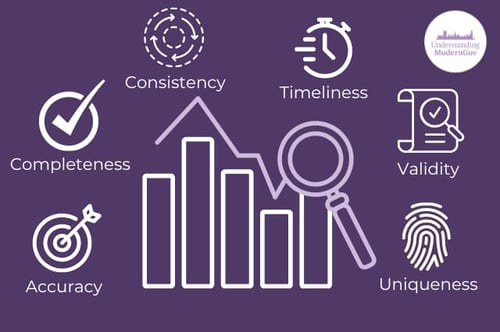The Data Quality Framework – Understanding the Six Data Quality Dimensions
 Matthew Kavanagh
·
4 minute read
Matthew Kavanagh
·
4 minute read
“The new oil” of the 21st century. That’s how The Economist defines data.
With each passing year, we become more reliant on technology, and we generate a mindboggling 2.8 exabytes of data each day.
That’s 2.8 billion gigabytes.
If you took every word every human has ever spoken in all of human history, scientists estimate it would be about 5 exabytes of data. Less than two days of our current overall data generation!
With so much data being generated already and with so much more still to come, it’s become more important than ever for governments, organisations, and businesses around the world to understand the importance of managing data correctly. A very large part of this is ensuring a high standard of data governance.
Legislation and regulation to ensure strong data protection are now standard across the world, reflecting the consensus around the importance of safeguarding our data.
However, data governance is a wide umbrella indeed, and there’s a lot more to it if you want to truly make sure you’re making the best use of your data. Complying with government and business regulations is just the first battle.
To be fully confident in your data, we need to talk about Data Quality- the next big thing in the world of Data.
But How do we Define Data Quality?
Clarity and confidence in your data is key. Data-driven decision-making can take your organisation to new heights, help you spot flaws and inefficiencies in your system and even give you great new ideas for what direction to take your team next.
To understand how to define data quality, think about these key questions:
- How much can you trust your data?
- How sure are you that data sets were input correctly?
- That it hasn’t been accidentally changed by that new employee clicking on the wrong button?
- That it wasn’t transferred over to a new system in the wrong date format, and nobody noticed and now your vital deadlines are scheduled two months late?
It sounds simple enough but, according to the Harvard Business Review, in 2017 only 3% of companies met basic data quality standards. They estimate that a staggering “47% of newly-created data records have at least one critical (e.g., work-impacting) error.”
Real-world data-driven decision-making needs high-quality data. Bad data could lead you to entirely wrong conclusions and cause serious issues down the line.
What is the UK Government’s Data Quality Framework?
The Data Quality Framework is a set of factors for public sector organisations to consider to ensure data quality. Here, we will walk you through the six Data Quality Dimensions and explain some of the common errors that can occur in each stage of the data lifecycle.
By reading through these steps, you can better understand the importance of good Data Quality management and ensure your team is ready to turn that digital oil into the fuel that will send your organisational rocket ship to the stars.
1. Accuracy
- A simple place to start, Accuracy refers to whether your data is correct. E.g. Is the address of a client correct? This dimension has a lot to do with data collection. Making sure your data collection practices are consistent and well-monitored for errors is the first step in building a strong data quality framework. Audit your data and if you find a mistake, do your best to track the lineage of the mistake. Where did it come from and how do you stop it from happening again?
To reduce these types of mistakes, find out why everyone should learn data skills.
2. Completeness
- How sure are you about your data completeness? For example, if you are surveying all the patients at a GP, but accidentally leave out a postcode, you’ve got an incomplete dataset and you might not even realise it. Any conclusions drawn from that dataset are based on an incomplete picture and could seriously impact your ability to make the right call.
3. Consistency
- In many organisations, data is stored across more than one system. If someone changes their contact information and it gets updated in the HR system, but not in the financial one, that incongruence can lead to confusion, inefficiency, and delays.
Particularly in the public sector, data is often shared across different systems and different departments or authorities. If this data is transferred incorrectly, it could have a significant impact on delivering vital services to people in need.
Find out more about the importance of information sharing in the public sector.
4. Timeliness
- For many areas of the public sector, like the NHS, timeliness is one of the most important factors in data quality. Depending on its purpose, data can lose quality over time, an address book from fifty years ago isn’t very useful right? Sometimes staff need to be sure that the data they have is fresh and most useful to their purposes. Ensuring data age is communicated clearly and plans are in place to update key data points when needed can be vital. Remember- a stitch in time saves nine!
5. Validity
- This refers to whether or not the value is possible for a given field. A good example would be trying to enter a date like February 29th or trying to input a phone number that is missing a digit.
By implementing a set of common-sense validity checks to ensure data such as postcodes or phone numbers are always valid, you can reduce potentially costly errors with some simple steps. Note, however, that just because data is valid, doesn’t necessarily make it accurate!
6. Uniqueness
- Finally, we have uniqueness. This refers to a data point only be found in your databases once. You want to avoid duplication as this can lead to miscommunications, inconsistency and other issues. This is a typical problem faced when merging two or more databases and is something to be vigilant about when doing so.
Ensuring that your organisation understands and applies these data dimensions to their work will keep your data quality high. High-quality data will lead to high-quality decisions and enhance your organisation’s ability to operate effectively.
Start Improving Your Organisation's Data Quality Today
From effective data sharing to creating data protection impact assessments, check the full list of our upcoming Data Compliance training courses today to improve how your organisation uses data and protects it.








